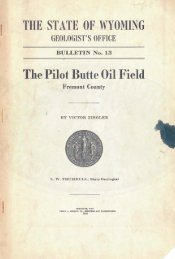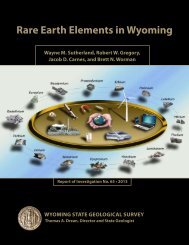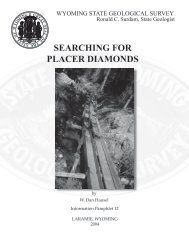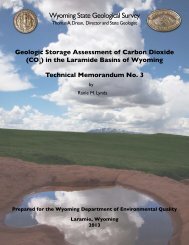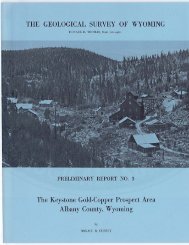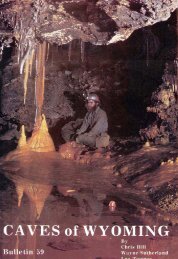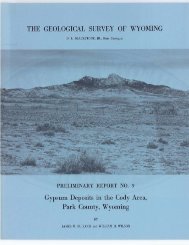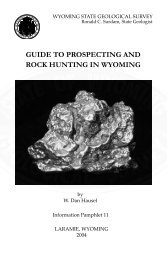The Dinosaurs of Wyoming - Wyoming State Geological Survey ...
The Dinosaurs of Wyoming - Wyoming State Geological Survey ...
The Dinosaurs of Wyoming - Wyoming State Geological Survey ...
Create successful ePaper yourself
Turn your PDF publications into a flip-book with our unique Google optimized e-Paper software.
50 THE DINOSAURS OF vVYOMIl TG<br />
<strong>The</strong> right ramus <strong>of</strong> the jaw <strong>of</strong> a three-horned dinosaur<br />
preserved in Yale University Museum, collected in <strong>Wyoming</strong>,<br />
exhibits a well-healed fracture. <strong>The</strong>re is no callus (Figure 42)<br />
but the jaw is deformed. <strong>The</strong> fracture may have been <strong>of</strong> the<br />
green-stick type.<br />
A broken and healed horn core <strong>of</strong> another three-horned<br />
dinosaur (Figure 41) may be evidence <strong>of</strong> a fight.<br />
An armor plate <strong>of</strong> a Stegosaurus, found in <strong>Wyoming</strong> shows<br />
a row <strong>of</strong> abcsessed pits as if a carnivorous dinosaur had bitten<br />
into the armor and the plate had become infected.<br />
Diseases <strong>of</strong> the joints, called arthritides, are fairly common<br />
among the dinosaurs, and are <strong>of</strong> different types. Perhaps the<br />
FIGURE 11.<br />
Drawing <strong>of</strong> a sawn hemisection <strong>of</strong> the large dinosaur tumor, shown in Figure 14.<br />
<strong>The</strong> dark lines represent bars <strong>of</strong> bone and the white areas are blood spaces. <strong>The</strong> tumor<br />
is an Haemangioma.<br />
most interesting joint lesion is that <strong>of</strong> a tumor which has<br />
united two caudal vertebrae into a solid mass (Figure 14).<br />
<strong>The</strong> specimen was found in <strong>Wyoming</strong> in the Como Beds, more<br />
than half a century ago. <strong>The</strong> tunlOr mass, after study, shows<br />
all the characters <strong>of</strong> what medical men call an haemangioma.<br />
a tumor filled with blood spaces tFiguTe 16). Its origin may<br />
have been due to an injury to the tail, at a point far back from<br />
the hips.<br />
<strong>The</strong> tumor mass resembles closely the tumor-like growths<br />
seen on live-oaks. Its mass has invaded the half <strong>of</strong> each vertebra<br />
and entirely filled up the space between the bones. <strong>The</strong><br />
specimen has a length <strong>of</strong> 26.5 cm. and a weight <strong>of</strong> 5.1 kg. <strong>The</strong><br />
tumor itself is 12 em. long. Its surface is rather deeply pitted<br />
.-




